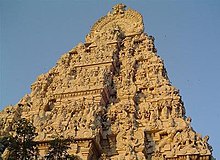Kanchi Kamakoti Peetham
| Acharya: Sri Jayendra Saraswati Swamigal | |
|---|---|

| |
| Location | Kanchipuram |
| Founder | Adi Shankara |
| First Acharya | Adi Shankara |
| Formation | 482 BC |
| Website | http://www.kamakoti.org/ |
Kanchi Kamakoti Peetham is a Hindu monastic institution located in Kanchipuram, Tamil Nadu and is one of the five pancha-bhUta-sthalas ("Temples denoting the five elements"). The five pancha-bhUta-sthalas or material sites represent earth (Kanchipuram), sky (Chidambaram), air (Kalahasti), fire (Thiruvannamalai), and water (Thiruvanaikoil). It is known formally as Shri Kanchi Kamakoti Peetam, and it is claimed to have been founded by the Adi Sankara. The head of the matha is referred to as a "Sankaracharya", a title that is also applied to the heads of the four Adi Sankara mathas.
The Kanchi matha has been gaining prominence since the 18th century, when it was at Kumbakonam. Today, it is one of the most important religious institutions in South India.
History
The matha claims to be founded by the Adi Sankara, although this claim is disputed by the other mathas of Adi Shankara, particularly Sringeri Sharada Peetham.[1][2]
Vijayendra Saraswati is the current pontiff, and the 71st in a line tracing its history back to the fifth century BCE. It is claimed that Sri Adi Sankara came to Kanchipuram, and that he established the Kanchi matha named "Dakshina Moolamnaya Sarvagnya Sri Kanchi Kamakoti Peetam" in a position of supremacy (Sarvagnya Peetha) over the other mathas of the subcontinent, before his attaining samadhi there.[citation needed]
The Kamakoti Peetam however, traditionally refers to Kamakshi referred popularly as Kamakodi. 'Kamakodi' is of Tamil origin, referring to Goddess Durga. 'Kodi' refers to Durga in the ancient Tamil Sangam literature. Kanchipuram is referred to as Kanchi. The Vyakarana Mahabhashya of Patanjali uses the word 'Kanchi' and it can be thus understood that the word Kanchi also has a Sanskrit base. It is claimed that under the guidance of Sureshvarachaya, Adi Shankara appointed Sarvajnatman as the second Peetadhipathi.[citation needed]
Chronological list of Sankaracharyas
Several historical records and traditional books purport to establish that Kanchi Mutt was established by Adi Sankara in 482 BC. The following order is a claim and cannot be verified conclusively.
The chronological list of Guru Paramapara of the matham follows:[citation needed]
- Adi Sankara Bhagavatpada (482 BC-477 BC)
- Suresvaracharya (477 BC-407 BC)
- Sarvajnatman (407 BC-367 BC)
- Sathyabodhendra Saraswati (367 BC-268 BC)
- Jnanandendra Saraswati (268 BC-205 BC)
- Suddhanandendra Saraswati (205 BC-124 BC)
- Aanandaghanendra Saraswati (124 BC-55 BC)
- Kaivalyanandayogendra Saraswati (55 BC-28 AD)
- Krpa Sankarendra Saraswati (28 AD-69 AD)
- Sureswara Saraswati (69 AD-127 AD)
- Sivananda Chidghanendra Saraswati (127 AD-172 AD)
- Chandrasekharendra Saraswati (172-235)
- Satchidghanendra Saraswati (235-272)
- Vidyaghanendra Saraswati (272-317)
- Gangadharendra Saraswati (317-329)
- Ujjvala Sankarendra Saraswati (329-367)
- Sadasivendra Saraswati (367-375)
- Shankarananda Saraswati (375-385)
- Martanda Vidyaghanendra Saraswati (385-398)
- Muka Sankarendra Saraswati (398-437)
- Chandrasekharendra Saraswati II (437-447)
- Bodhendra Saraswati (447-481)
- Satchisukhendra Saraswati (481-512)
- Chitsukhendra Saraswati (512-527)
- Satchidanandaghanendra Saraswati (527-548)
- Prajnaghanendra Saraswati (548-565)
- Chidvilasendra Saraswati (565-577)
- Mahadeve11dra Saraswati I (577-601)
- Purnabhodhendra Saraswati (601-618)
- Bhodhendra Saraswati II (618-655)
- Brahmanandaghanendra Saraswati (655-668)
- Chidanandaghanendra Saraswati (668-672)
- Satchidananda Saraswati (672-692)
- Chandrasekharendra Saraswati III (692-710)
- Chitsukhendra Saraswati (710-737)
- Chitsukhanandendra Saraswati (737-758)
- Vidyaghanendra Saraswati III (758-788)
- Abhinava Sankarendra Saraswati (788-840)
- Satchidvilaasendra Saraswati (840-873)
- Mahadevendra Saraswati II (873-915)
- Gangadharendra Saraswati II (915-950)
- Brahmanandaghanendra Saraswati (950-978)
- Anandaghanendra Saraswati (978-1014)
- Purnabhodhendra Saraswati II (1014-1040)
- Paramasivendra Saraswati I (1040-1061)
- Sandranandabhodhendra Saraswati (1061-1098)
- Chandrasekharendra Saraswati IV (1098-1166)
- Advaitanandabodhendra Saraswati (1166-1200)
- Mahadevendra Saraswati III (1200-1247)
- Chandrachudendra Saraswati I (1247-1297)
- Vidyateerthendra Saraswati (1297–1385)
- Sankaranandendra Saraswati (1385–1417)
- Purnananda Sadasivendra Saraswati (1417–1498)
- Vyasachala Mahadevendra Saraswati (1498–1507)
- Chandrachudhendra Saraswati II (1507–1524)
- Sarvajna Sadasiva Bhodhendra Saraswati (1524–1539)
- Paramasivendra Saraswati II (1539–1586)
- Atma Bodhendra Saraswati (1586–1638)
- Bodhendra Saraswathi (1638–1692)
- Advaitatma Prakasendra Saraswati (1692–1704)
- Mahadevendra Saraswati IV (1704–1746)
- ChandrasekharendraSaraswati V (1746–1783)
- Mahadevendra Saraswati V (1783–1813)
- Chandrasekharendra Saraswati VI (1813–1851)
- Sudarsana Mahadevendra Saraswati (1851–1891)
- Chandrasekharendra Saraswati VII (1891 - February 7, 1907)
- Mahadevendra Saraswathi V (February 7, 1907 - February 13, 1907)
- Jagadguru Chandrashekarendra Saraswati Swamigal (February 13, 1907 - January 3, 1994)
- Jagadguru Jayendra Saraswathi Swamigal
- Jagadguru Vijayendra Saraswati Swamigal
References
- ^ Roshen Dalal (18 April 2014). Hinduism: An Alphabetical Guide. Penguin Books Limited. p. 613. ISBN 978-81-8475-277-9.
- ^ Varanasi Raj Gopal Sharma (1987). Kanchi Kamakoti Math, a Myth. Ganga-Tunga Prakashan.
External links
